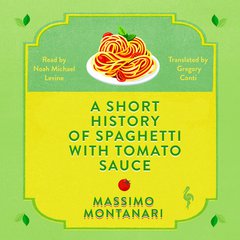Massimo Montanari
A Short History of Spaghetti with Tomato Sauce
ISBN: 9781787705234
Translated by: Gregory Conti
Region: Italy
Book collection: Europa Compass
The book
Read by Noah Michael Levine
THE MYTHS SURROUNDING THE WORLD’S FAVOURITE DISH, DEBUNKED
Did Marco Polo bring pasta back from China, or is that a myth?
How did the Neapolitan “macharoni” turn into the ubiquitous spaghetti?
Is it even an Italian dish?
Hundreds of shapes and thousands of recipes give expression to the culture and products of the country’s regions. But spaghetti with tomato sauce remains Italy’s identity dish par excellence.
Massimo Montanari goes in search of the dish’s true origins, tracing its history along the multiple, intricate routes taken by its raw ingredients to merge and become a distinctive element of culinary tradition.
It took almost two thousand years and input from the Far East, the Arabic world, and the Americas, for the dish to take centre stage. Its development is the result of chance encounters, unplanned exchanges, and unpredictable intersections. As we dig in search of spaghetti’s origins, we find its strands wrap right around the world.
“Montanari traces the unstoppable rise of what would become the most famous dish in the whole world.”
—Robinson/La Repubblica
“A learned and entertaining volume.”
—Il Giornale
“Al dente”: this untranslatable expression (indeed, the English version is identical to the Italian, literally “to the tooth”) evokes in a synthetic fashion an essential element of Italian gastronomic culture, pasta, and at the same time, the proper way to cook it: not too long, in order to keep it firm to the bite. Nevertheless, medieval and Renaissance cookbooks recommended cooking pasta a long time, for a number of minutes that today would leave us aghast. “These macaroni want to boil for the space of two hours,” Maestro Martino prescribes in his recipe for Sicilian macaroni. The indication was apparently susceptible to rather significant variations, with another manuscript of the same book reducing the cooking time to “one hour gently gently” and still another takes it down to “half an hour”— adding, however, that in principle “all pasta wants to be well cooked.” Bartolomeo Scappi, in the 1500s, also suggests prolonged cooking. For his “Romanesque macaroni dish” he advises pre-cooking in boiling water for half an hour, then “taste them to see if they are tender, and if not, keep them at a boil until they are well cooked.” That’s not all. “At this point, the pasta is put onto a plate, arranged on three layers each topped with grated cheese, sugar, and cinnamon, then the whole thing is covered with an overturned plate and left to stew on the hot coals, or in the oven, for another half hour.”
The author
Massimo Montanari
Massimo Montanari, currently Professor of Medieval History at Bologna University, is a scholar in Food Studies. He has been invited as visiting professor to a number of leading universities in Europe, Japan, the United States, Mexico and Canada, and is one of the founders of the international review Food & History.



